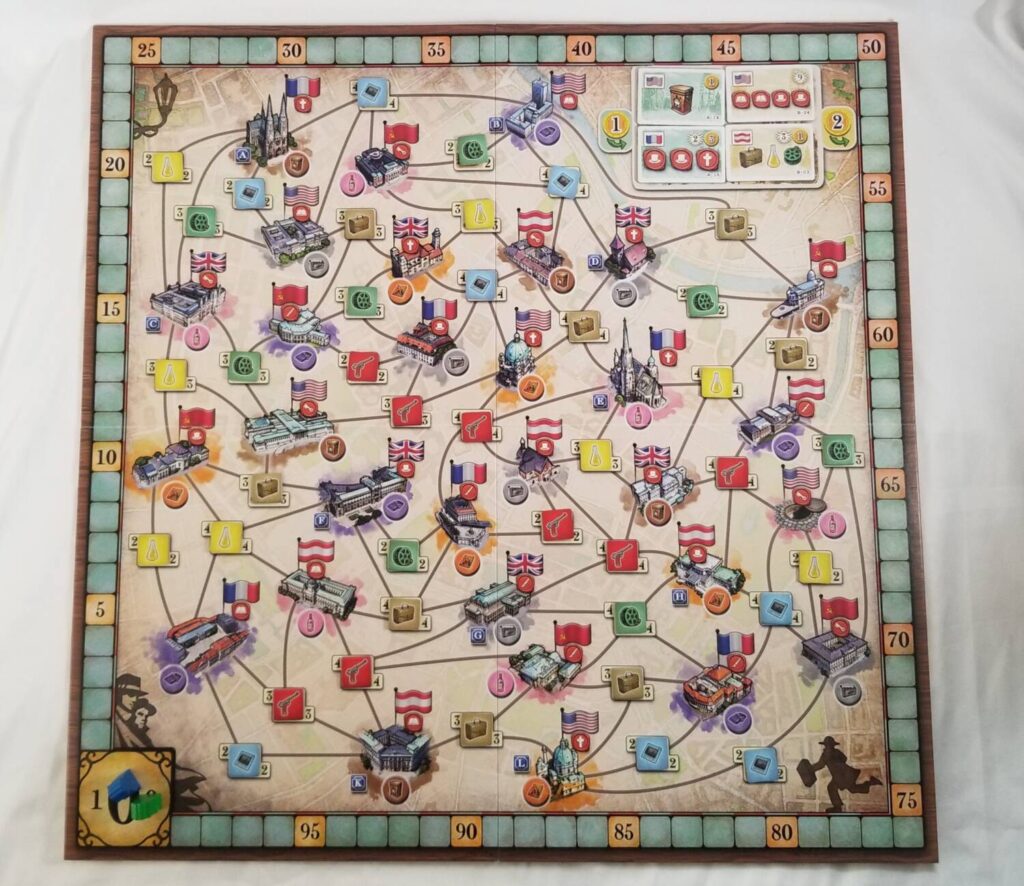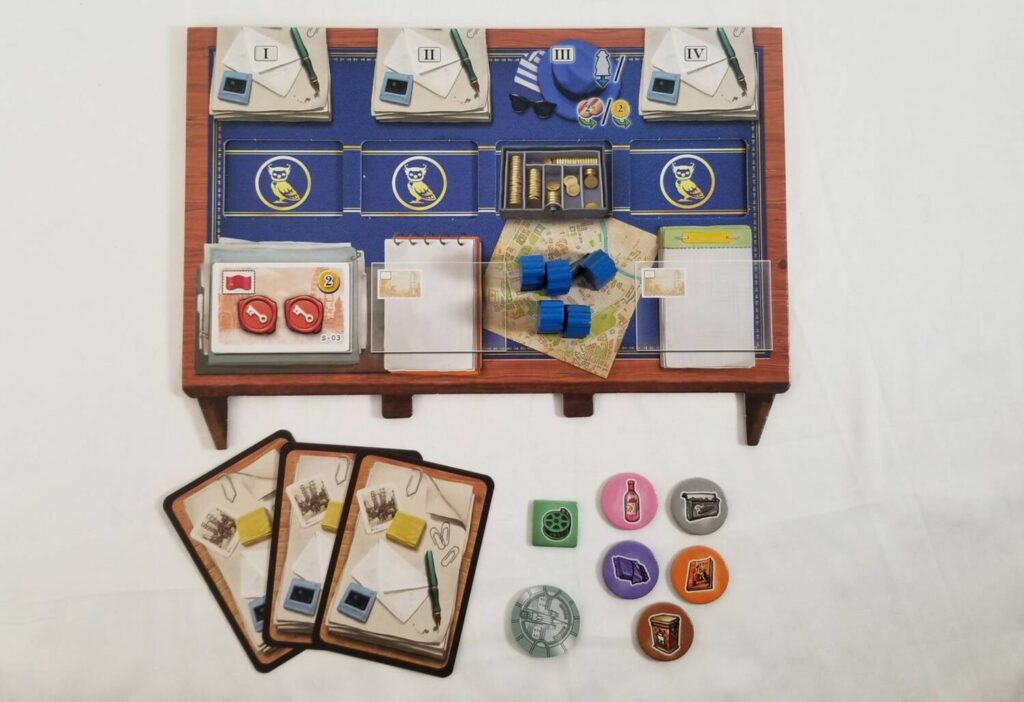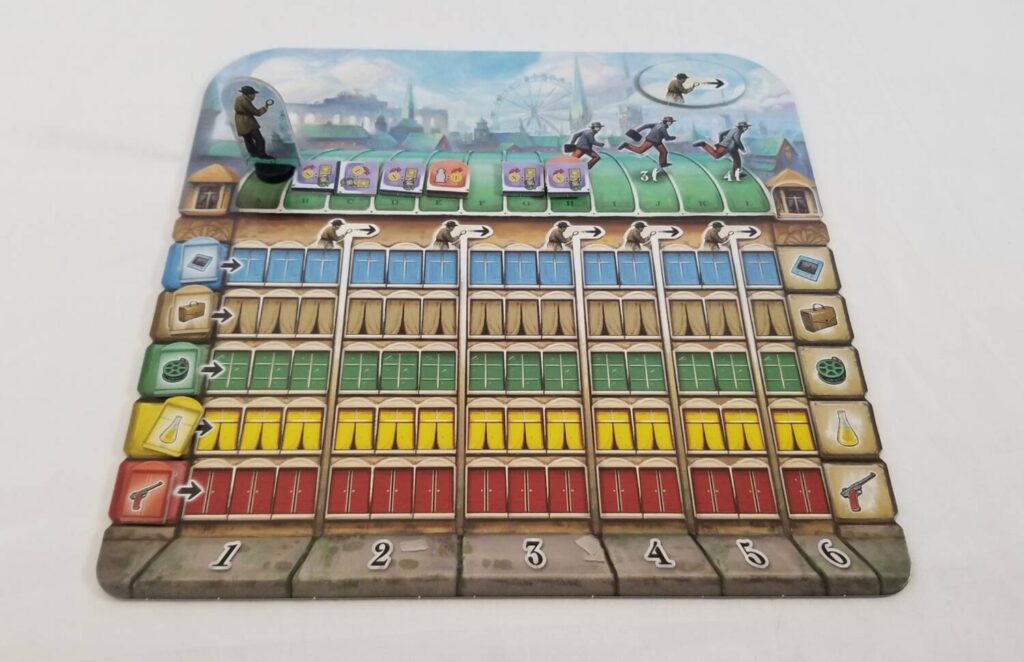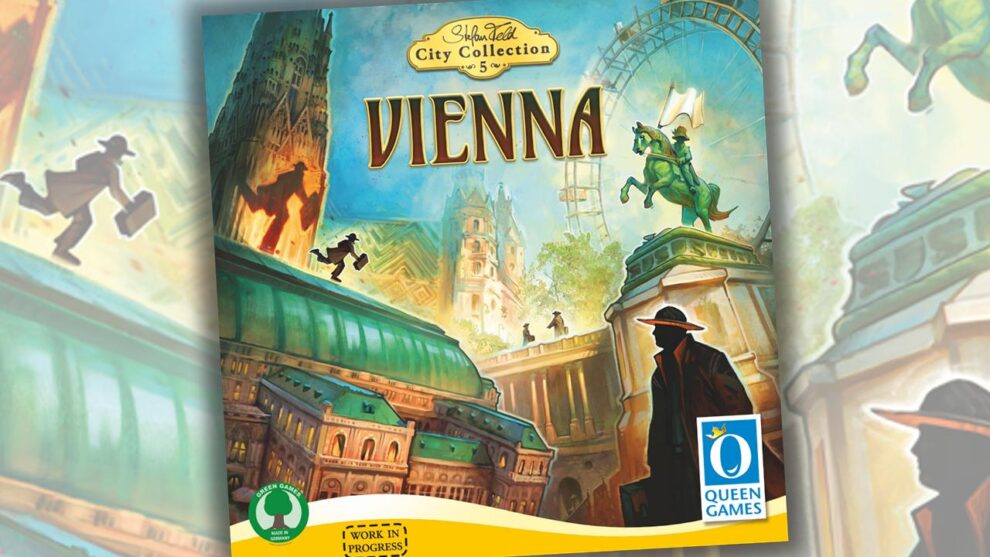Hello and welcome to ‘Focused on Feld’. In my Focused on Feld series of reviews, I am working my way through Stefan Feld’s entire catalogue. Over the years, I have hunted down and collected every title he has ever put out. Needless to say, I’m a fan of his work. I’m such a fan, in fact, that when I noticed there were no active Stefan Feld fan groups on Facebook, I created one of my own.
Today we’re going to talk about 2023’s Vienna, his 37th game.
Vienna is the 5th title in the Stefan Feld City Collection (SFCC). Vienna is played in one of two modes: an introductory version and an advanced mode. The introductory version is a nearly pound-for-pound reimplementation of Feld’s 2014 classic La Isla. In fact, if you want to get a firm grasp on how the introductory version is played, you can check out my review of La Isla and walk away with a decent idea. The terminology for the different parts has changed, and the two themes are as dissimilar as can be, but the concepts are the same.
Rather than focus on the game play itself, in this review I am going to focus on two things: What’s Changed? And What’s New? If you’re already familiar with the answers to these questions and just want to know what I think, feel free to skip ahead to the Thoughts section. Otherwise, read on as we talk about Vienna.
The Basics
In La Isla, the players are explorers on a mysterious island. Using multi-use cards, they will gain access to new abilities and also acquire colored cubes that are used to place their explorers onto the map to surround animal tiles and capture those tiles for points. In Vienna, the players are spies living in the titular city during the early 1950s. In the introductory version, they’ll be using multi-use cards to acquire Bribe tokens which are used to place their spies onto the map, surrounding secret information tiles, to take them into their possession to score points.

As I mentioned earlier, the similarities are striking. If that’s all there was to it, I would have just gone back into my review of La Isla and tacked on an extra few paragraphs—similar to what I did for Jórvík and The Speicherstadt. But there have been some significant changes and additions that may sway you in favor of one over the other.
What’s Changed?
The most glaringly obvious difference between Vienna and its predecessor is the theme. Artistically and cosmetically, the two games are very different and, if you weren’t in the know, you’d be hard pressed to tell that they’re basically the same game. Those cosmetic changes go beyond the artwork, though. There are also several component changes.
For instance, Vienna includes full-fledged recessed player boards (as opposed to the flimsy cardboard things provided in La Isla). There’s also a Storage board included that organizes the various bits and baubles into one singular, organized place. This Storage board is double-sided for use in the advanced mode where it acts as more than just a place to store things, but as a market of sorts as well. It’s also worth mentioning that, instead of several modular pieces (like in La Isla), the game board is one solid, foldable object now. One side is for the basic game and, like the Storage board, it is flipped to its opposite side for the advanced mode.

This brings to mind another subtle change. La Isla’s variable setup was provided by the modular board pieces, but there would always be some board elements that never differed because they all existed on the same modular piece. In Vienna, the players have been provided a number of Flag tiles that can be used to cover the pre-printed flag tiles. This not only mimics the modularity of La Isla, but it also improves on it slightly by shuffling the board elements even more.
Beyond the artwork and components, there are a couple of gameplay elements that exist in both modes of Vienna that differ from La Isla and bear mentioning. In La Isla, instead of placing an explorer on your turn, you can opt to take a single cube of your choice from the general supply and add it to your own. In Vienna, instead of sending out an agent, you can opt to take two bribes (the equivalent of La Isla’s cubes) of the same type from the general supply and add them to your own.
While that may seem like a negligible difference, it’s actually pretty huge. In La Isla, even with taking a cube, there would be many times where you’d find yourself struggling to come up with what you needed to send out your explorers, especially if the location you were collecting cubes for got snatched up by someone else. In Vienna, like La Isla, it takes two bribes of the same kind to send your agent anywhere. Being able to grab two bribes instead of just one virtually guarantees you’ll be able to send out an agent on your next turn, barring nobody taking the move you were hoping to take yourself.

Lastly, the endgame for La Isla is triggered based on how high the various animal markers have moved up their respective tracks. While functional, it’s a clunky system that often results in a lot of confusion with newer players. In Vienna, the process is streamlined. Every round, in Phase IV, the card you chose is going to cause one of the Secret Information trackers to move forward on their track by a single space—scoring you points if you happen to have any of the matching Secret Information tiles in your personal supply. If that causes one of them to cross a dividing line, and it’s the first one to do so that round, the Investigator standee moves up a space on the roof, which acts as the game’s timer. Further actions that would cause one or more Secret Information trackers to cross dividing lines that round have no effect. Once the investigator reaches the space for your player count, the end of the game is triggered.
While that may sound confusing, trust me when I say that, in practice, it’s very easy to navigate.
What’s New?
It’s Vienna’s advanced mode that truly sets it apart from its predecessor. La Isla’s advanced mode just saw you shuffling a few extra cards into the deck. Vienna’s, on the other hand, brings a lot of entirely new components and concepts into play (in addition to the extra cards).
In Vienna’s advanced mode, the main game board and the Storage boards are flipped to their opposite sides during setup. On the main board, in addition to the flags, bribe type, and color types displayed on the introductory version side, there are also letters (house number plates) and red seals. These symbols are linked to the new concept of ‘missions’ (which I will talk about momentarily).
The Storage board is seeded with face down Mission tiles, two draw piles of shuffled cards (the cards from the introductory version mixed with the cards from the advanced mode), and the various Bribe tokens. There is also an extra sideboard that stores even more stuff: money, desk tiles (which I’ll talk about later), extra agents, and Side Table tiles (one in each player color).
The tracking board with the Secret Information trackers and Investigator standee also sees some new elements introduced to it: a series of Purchase and Payday tiles. As the Investigator standee encounters these tiles, players will have the opportunity to purchase the upgrades from the Storage sideboard, or the players will be forced to pay for each agent they have on the board if they wish to keep them placed on the board.
You heard that right, the advanced mode introduces upkeep.
Missions
Missions are stored in the recessed areas of each player’s Player board. Each player will receive a starting Mission during setup, but more can be acquired during the game (to a maximum of three at a time).
During Phase III of a turn, when placing agents onto the board, the active player will have the option of taking on a new mission with a flag matching the building their agent was just placed onto OR completing one or more missions with a matching flag. Much like the Mission cards in Merlin, players do not need to spend anything to complete the missions. They just need to demonstrate that they have met the criteria for completing them. Then, they earn the reward shown before discarding the tile.
Money
The Vienna advanced mode introduces the concept of money, which is needed to not only purchase things, but to pay for the upkeep of their agents during Paydays as well. Each player begins the game with a single shilling, but more can be acquired by taking on new missions or as rewards for completing certain missions.

During Paydays, players must pay a shilling for each of their agents on the game board. Otherwise, they have to remove the ones they cannot pay for.
During a Purchase phase, players may spend their money to acquire various upgrades, of which there are six types. They (and their costs) are:
– Hire an agent (1): add an agent to your personal supply
– Telephone (2): allows you to draw extra cards, thereby giving you more options on your turn
– Road Map (2): allows you to pay using bribes and/or coins during Paydays
– Cash Box (2): money earned can be banked in the cash box where it will be worth points at the end of the game. The Cash Box also earns the player more money when accepting new missions.
– Seal (2): Rewards three extra points for each resolved Mission tile (in addition to whatever the Mission tile would normally provide)
– Side Table (3): Provides a fourth drawer (i.e. space to store a fourth card ability) and space for a fourth Mission tile.
But, wait. There’s…
More
Also included in the box is a Stefan Feld standee which is used in not one, but two, expansions. Both expansions are playable using the introductory version or the advanced modes of the game. The first expansion, called ‘The Third Man’, introduces a neutral figure (represented by the Feld standee) which any player can use, in conjunction with their own agents, to surround—and subsequently collect—Secret Information tiles.

The second expansion uses the Feld standees from the first four games in the SFCC. Each player receives one of these, and it’s used just like a typical agent with a couple of caveats:
- The players do not pay him in shillings during Paydays, but must bribe him with chocolate instead.
- Each Feld standee has a unique ability that is imparted onto the player. The ability is dependent on the standee’s color.
The obvious drawbacks of this second expansion are that a.) you must own the first four SFCC games to use it and b.) you’ve got to dig the standees out of the other four boxes before you can use it. As such, unless you’re willing to do that each and every game (or come up with some kind of viable substitute), this second expansion isn’t likely to see much table time.
Thoughts
I have mixed feelings about Vienna. On the one hand, I appreciate all the new concepts and variety that it brings to the table. On the other hand, I wonder if it’s a bit too much. Half of La Isla’s charm is that there’s so much complexity hiding beneath the extremely simple ruleset. The other half comes from the theme and the visuals that lend credence to that theme. From the artwork that evokes the feeling of a lush, tropical rainforest to the plastic explorer standees, La Isla’s theme drips from every pore, even if some of the component quality leaves a lot to be desired.
Vienna loses much of that charm, trading the fantasy of a newly discovered tropical island for the austerity of a bustling city. La Isla, at first glance, looks like a light-hearted romp. Vienna looks like a game that takes itself seriously. Where La Isla’s island locations make it easy to see where everything is and how it is connected to everything else, Vienna’s a confusing mess of intersecting lines, like the classic image of an investigator using pushpins and red yarn to tie together the various pieces of evidence on a corkboard.
To put it succinctly, Vienna’s table presence isn’t doing it any favors.
That being said, Vienna’s positives far outweigh its negatives. The overall component quality is worlds apart from the flimsy feel of La Isla. The wooden components are top notch. The cardboard is thick. The cards are large enough to be shuffled easily (a claim that La Isla cannot make). While it feels like virtually every alea game was produced on a shoestring budget, everything I’ve ever touched that was produced by Queen Games gives me the impression that QG spares no expense. Regardless of what you think about their customer service or their pricing (and, yes, the SFCC games are VERY pricey—even the standard editions), they always produce a good product.
Even without the expansion (which is literally a cardboard standee with a plastic base), Vienna’s advanced mode offers so much more depth than anything La Isla has to offer. Were it not for this, I would never recommend Vienna to anyone over the much more affordable La Isla. As it stands, though, when measured up against one another, Vienna has the edge over its predecessor.
From now on, when I have the urge to get La Isla to the table, it’s Vienna I will be pulling off of the shelf.











Add Comment